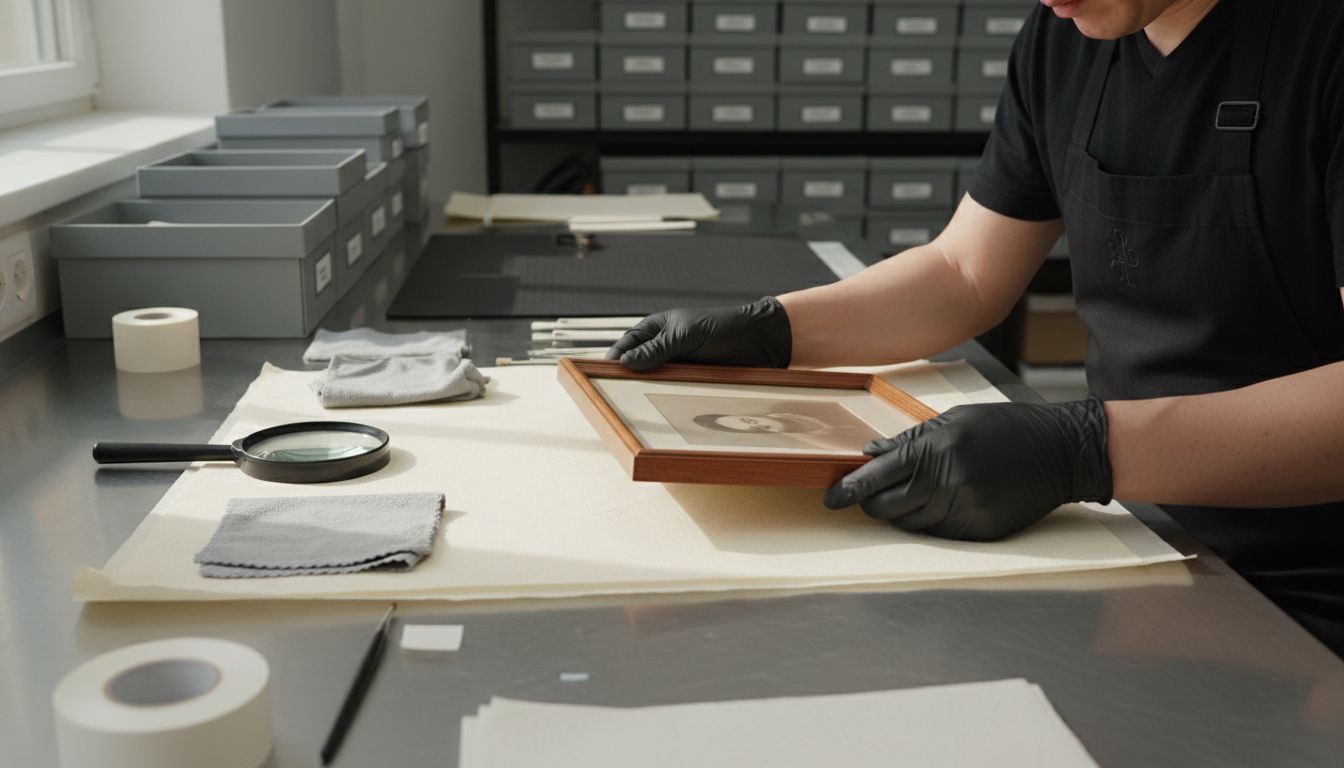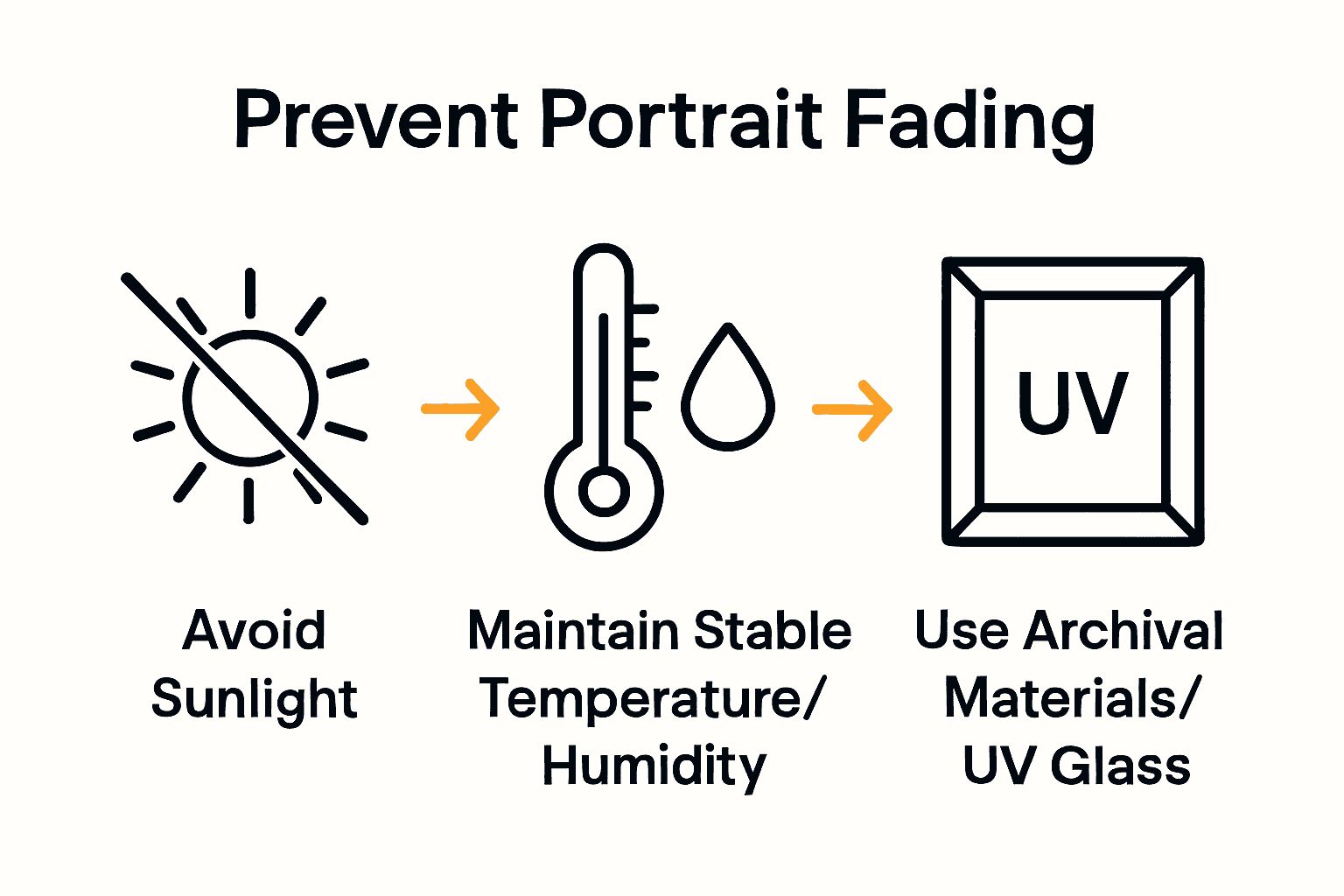
How to Preserve Portrait Quality for Timeless Memories
Share
Did you know that even just a few months of sunlight exposure can cause a portrait to fade by over 30%? Portraits hold irreplaceable memories, yet many people accidentally put their artwork at risk just by choosing the wrong display spot or using improper care. Protecting your cherished pictures does not have to be complicated. A few simple steps can make all the difference in keeping your portraits vibrant and damage free for years to come.
Table of Contents
- Step 1: Choose the Optimal Display Environment
- Step 2: Handle Portraits with Clean, Dry Hands
- Step 3: Use Protective Framing and UV Glass
- Step 4: Regularly Dust and Inspect Portrait Surfaces
- Step 5: Store Originals in Climate-Controlled Areas
Quick Summary
| Key Point | Explanation |
|---|---|
| 1. Choose an ideal display environment | Select a spot with controlled light and stable temperatures to prevent fading and deterioration. |
| 2. Handle with clean, dry hands | Always use gloves and touch only the edges to prevent damage from oils and dirt. |
| 3. Use protective framing and UV glass | Frame portraits with archival materials and UV-filtering glass to protect from dust and light damage. |
| 4. Regularly dust and inspect surfaces | Create a maintenance routine to catch potential issues early and keep the portrait clean. |
| 5. Store originals in climate-controlled areas | Use stable, moisture-controlled storage solutions to prevent environmental damage to your artwork. |
Step 1: Choose the Optimal Display Environment
Selecting the perfect location to showcase your cherished portrait means understanding how environmental conditions can impact its long-term preservation. Your goal is creating a display space that protects and celebrates the artwork while preventing potential damage.
According to National Archives, prolonged exposure to light especially ultraviolet (UV) radiation can cause significant fading in photographs. This means you’ll want to strategically choose areas with controlled lighting and minimal direct sunlight. Look for spots in your home with soft, indirect natural light or consider using specialized UV-filtering glass to protect your portrait.
As recommended by Surrey County Council, temperature and humidity play crucial roles in preservation. Avoid displaying portraits in rooms with dramatic temperature shifts like attics or basements. Instead, select spaces with consistent environmental conditions preferably between 60-70 degrees Fahrenheit with moderate humidity levels around 50%. Your portrait will thank you by maintaining its vibrant colours and pristine condition for generations to come.
Quick pro tip? Position your portrait away from heating vents windows and direct sunlight streams. Think protection meets aesthetic elegance.
Step 2: Handle Portraits with Clean, Dry Hands
Preserving the pristine quality of your cherished portrait begins with understanding how delicate these memories can be. Your goal is to protect the artwork from potential damage caused by improper handling.
According to National Archives, proper handling requires wearing nitrile or vinyl gloves to shield the photograph from skin oils and dirt. While cotton gloves might seem like a good option they can actually transfer fibers and reduce your dexterity. The key is to always handle portraits by their edges avoiding direct contact with the image area.
As recommended by Surrey County Council, careless handling can lead to irreversible damage. Before touching your portrait ensure your hands are completely clean and thoroughly dry. If possible create a clean workspace with a soft surface like a clean cotton cloth or archival quality paper to provide additional protection. When moving or repositioning the portrait use gentle movements and maintain a steady grip along the outer edges.
Pro tip? Think of your portrait like a delicate museum artifact. Slow deliberate movements and minimal direct contact are your best defence against accidental damage.
 Ensuring Photo Quality for Portraits: A Family Approach offers more insights into protecting your precious memories.
Ensuring Photo Quality for Portraits: A Family Approach offers more insights into protecting your precious memories.
Step 3: Use Protective Framing and UV Glass
Safeguarding your precious portrait involves more than careful handling. Your ultimate goal is creating a protective environment that preserves the artwork’s colour vibrancy and structural integrity for years to come.
According to National Trust, using glazed frames is crucial to protect photographs from dust and potential physical damage. Avoid tempting but harmful storage solutions like magnetic albums with sticky pages which can gradually deteriorate your portrait over time. Instead invest in high quality archival framing that offers comprehensive protection.
Research from Icon recommends using UV filtering glazing as a critical defence against light exposure. When selecting your frame and glass look for materials made from 100% neutral polyester or archival quality papers that are lignin free and sulphur free. These specialist materials create a protective barrier that shields your portrait from environmental threats while maintaining its original beauty.
Pro tip? Position your framed portrait away from direct sunlight and choose museum grade glass that blocks harmful UV radiation. What is High-Detail Portraiture? Understanding Its Artistry can provide additional insights into preserving your artwork’s intricate details.
Step 4: Regularly Dust and Inspect Portrait Surfaces
Maintaining the pristine condition of your cherished portrait requires consistent care and attention. Your mission is to create a proactive preservation strategy that catches potential issues before they become irreversible damage.

According to Scottish Archives, regular inspection is crucial for detecting early signs of deterioration. Use a soft microfibre cloth or specialised photography cleaning brush to gently remove surface dust. When cleaning be extremely gentle and avoid applying any pressure that might scratch or damage the portrait. A vacuum with a HEPA filter can be helpful for removing ambient dust from the surrounding area without directly touching the artwork.
Research from National Archives Blog emphasises the importance of creating a safe environment for your portrait. Keep food and drink far away from your artwork to prevent accidental spillages. During your inspection look for subtle signs of damage such as discolouration fading or tiny surface irregularities. If you notice anything unusual consider consulting a professional conservator who can provide expert guidance.
Pro tip? Create a regular maintenance schedule perhaps once every few months to ensure consistent care. Choosing the Best Portrait Photo for Stunning Results can offer additional insights into preserving photographic memories.
Step 5: Store Originals in Climate-Controlled Areas
Preserving your treasured portrait requires more than careful handling. Your mission is to create a stable storage environment that protects your artwork from environmental threats and potential degradation.
According to Surrey County Council, storing photographs demands careful consideration of environmental conditions. Avoid storing your portrait in unpredictable spaces like attics or basements where temperature and humidity fluctuate dramatically. Instead select a dedicated storage area with consistent temperature and minimal moisture. Look for storage furniture constructed from non combustible materials that allow proper air circulation and prevent the formation of stagnant air pockets.
Research from Icon recommends maintaining a stable environment with relative humidity between 30 and 40 percent. Invest in a small dehumidifier or humidity control system if needed to maintain these precise conditions. When storing your portrait use archival quality boxes or folders that protect against dust moisture and potential physical damage. Place acid free tissue paper between photographs to prevent sticking and additional protection.
Pro tip? Think of your storage space like a museum archive protecting irreplaceable artefacts. Ensuring Photo Quality for Portraits: A Family Approach can provide additional guidance on creating the perfect preservation environment.
Preserve Your Precious Memories with Expert Care
Keeping your portrait quality intact for years demands more than just careful handling. It means choosing the right environment, protecting your artwork from light damage, and using archival framing as highlighted in our trusted article. If you feel the responsibility of conserving timeless memories weighing on you, remember you are not alone. Many desire their portraits to remain as vivid and enchanting as the day they were created.
Discover how custom pieces from The Family Portrait Companys Home page bring your treasured moments to life while offering expert advice on care and display.

Experience the joy of having bespoke pet and human portraits crafted with care and designed for longevity. Start protecting your family’s legacy today by visiting our landing page to find the perfect custom portrait solution. Act now and transform your memories into artworks designed to be cherished through generations.
Frequently Asked Questions
How can I choose the best display environment for my portrait?
Selecting a display environment requires avoiding direct sunlight and areas with temperature fluctuations. Aim for a location with consistent temperatures between 60-70 degrees Fahrenheit and moderate humidity levels around 50%. Consider using UV-filtering glass to protect your portrait from light damage.
What steps should I take to handle my portrait safely?
To handle your portrait safely, always wear nitrile or vinyl gloves and ensure your hands are clean and dry. Grip the portrait by its edges and avoid touching the image area to prevent oils or dirt from causing damage.
How do I properly frame my portrait for long-term preservation?
Use high-quality archival framing with UV-filtering glass to protect your portrait from dust and light exposure. When framing, look for materials that are lignin-free and sulfur-free to maintain the original beauty of the artwork for years to come.
How frequently should I dust and inspect my portrait?
Dust and inspect your portrait every few months to catch any signs of deterioration early. Use a soft microfibre cloth to gently remove dust and look for changes like discoloration or tiny surface irregularities that may indicate damage.
What is the best way to store original portraits?
Store your original portraits in a climate-controlled area with stable temperatures and humidity levels between 30-40 percent. Use archival quality boxes or folders for protection, and place acid-free tissue paper between photographs to prevent sticking and damage.
How can I create a maintenance schedule for my portrait care?
Establish a maintenance schedule to care for your portrait, planning tasks like dusting and inspection every few months. This regular attention will help you preserve its quality and ensure any issues are addressed promptly.
Recommended
- Choosing the Best Portrait Photo for Stunning Results – The Family Portrait Companys
- 7 Essential Tips for a Memorable Custom Portrait Gift Guide – The Family Portrait Companys
- Ensuring Photo Quality for Portraits: A Family Approach – The Family Portrait Companys
- Understanding Why Custom Portraits Last Through Time – The Family Portrait Companys
